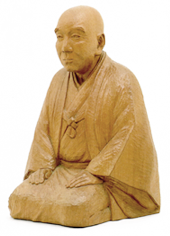Hayami Tea ceremony school
Japanese tea ceremony is said to have been passed down for approximately 500 years, primarily as a form of spiritual Zen practice (Sen no Rikyū's tea) and as a reflection of samurai morality (buke-cha tea). However, even prior to this period, Japanese tea was already enjoyed by the nobility some 600 years ago. The practice was revived by the founder of Hayami-ryū School of Tea during the late Edo period, and endorsed by Emperor Kōkaku and the Imperial family at the time. The Hayami-ryū School has faithfully continued the tradition of passing down the teachings and philosophy of the founder from generation to generation.
The origins of Hayami-ryu

The Hayami-ryū School of Tea was founded by Hayami Sōtatsu (1739-1809) over 250 years ago. Sōtatsu was born into a family of court physicians but, from a young age, chose to study the Chinese classics and ancient Japanese poetry, and became a disciple of Ittō Sōshitsu, the 8th grand master of the Urasenke school. At the age of 21, having been granted the status of Tea Master, Sōtatsu dedicated himself to researching and reviving the original style of the Japanese Tea Ceremony that was enjoyed by Emperor Gohanazono (1419-1471). Hayami-ryū soon found favour and support from Emperor Kōkaku (1771-1840) and the aristocracy of the time, including the Emperor’s brother Mitsuhito, as well as attracting feudal lords from throughout the country seeking to learn Sōtatsu’s tea style.
About Hayami-ryū
In Japan there is an aesthetic concept known as "wabi-sabi," but the Hayami-ryū Tea Ceremony School also values the Japanese tradition of "miyabi" (elegance / refinement). Our fukusa (tea ceremony silk cloths) combines two colors based on the twelve-layered kimono worn by court ladies a millennium ago. Our design of fish scales (uroko), which represent protection from evil, is slightly offset at the corners to indicate "front and back" and "yin and yang." The fukusa used to serve tea to the Emperor and his relatives is designed so that both the front and back of the cloth can be seen at a glance, so that the purest part can be immediately identified. In addition, Hayami-ryū uses a type of washi paper called a tatōshi, which is the same kind of washi paper court ladies of the Heian era carried tucked in the chest area of their kimono, in a manner understood to convey their deep reverence toward the upper ranks of the nobility (unjōbito). In Hayami-ryū practice, the fukusa is placed inside the folded tatōshi, and placed in the chest area to prevent body heat being transferred to the cloth.
Hayami Sōen: 8th Generation Grand Master (iemoto)
Sōen is dedicating himself to maintaining the etiquette and style of the tea ceremony created by the Founder, who enjoyed the support of Emperor Kōkaku, and whose reign is remembered for his protection and promotion of Japanese culture. In recent years, the iemoto has renewed Hayami-ryū’s ancient ties with the Ichijō family, one of the Five Regent Families, who held the most prestigious positions in the imperial court. He has also renewed relationships with the descendants of the former nobles who moved from Kyoto to Tokyo 150 years ago, and is working to revive the courtly manner of the tea ceremony practiced at the Founder’s time.
